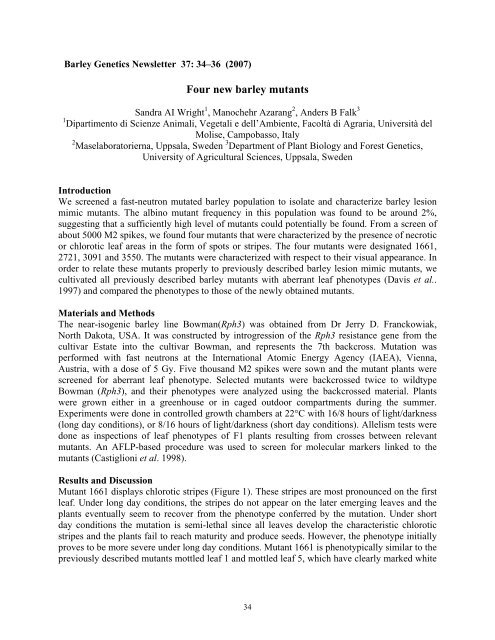BARLEY GENETICS NEWSLETTER - GrainGenes - US Department ...
BARLEY GENETICS NEWSLETTER - GrainGenes - US Department ...
BARLEY GENETICS NEWSLETTER - GrainGenes - US Department ...
You also want an ePaper? Increase the reach of your titles
YUMPU automatically turns print PDFs into web optimized ePapers that Google loves.
Barley Genetics Newsletter 37: 34–36 (2007)<br />
Four new barley mutants<br />
Sandra AI Wright 1 , Manochehr Azarang 2 , Anders B Falk 3<br />
1 Dipartimento di Scienze Animali, Vegetali e dell’Ambiente, Facoltà di Agraria, Università del<br />
Molise, Campobasso, Italy<br />
2 Maselaboratorierna, Uppsala, Sweden 3 <strong>Department</strong> of Plant Biology and Forest Genetics,<br />
University of Agricultural Sciences, Uppsala, Sweden<br />
Introduction<br />
We screened a fast-neutron mutated barley population to isolate and characterize barley lesion<br />
mimic mutants. The albino mutant frequency in this population was found to be around 2%,<br />
suggesting that a sufficiently high level of mutants could potentially be found. From a screen of<br />
about 5000 M2 spikes, we found four mutants that were characterized by the presence of necrotic<br />
or chlorotic leaf areas in the form of spots or stripes. The four mutants were designated 1661,<br />
2721, 3091 and 3550. The mutants were characterized with respect to their visual appearance. In<br />
order to relate these mutants properly to previously described barley lesion mimic mutants, we<br />
cultivated all previously described barley mutants with aberrant leaf phenotypes (Davis et al..<br />
1997) and compared the phenotypes to those of the newly obtained mutants.<br />
Materials and Methods<br />
The near-isogenic barley line Bowman(Rph3) was obtained from Dr Jerry D. Franckowiak,<br />
North Dakota, <strong>US</strong>A. It was constructed by introgression of the Rph3 resistance gene from the<br />
cultivar Estate into the cultivar Bowman, and represents the 7th backcross. Mutation was<br />
performed with fast neutrons at the International Atomic Energy Agency (IAEA), Vienna,<br />
Austria, with a dose of 5 Gy. Five thousand M2 spikes were sown and the mutant plants were<br />
screened for aberrant leaf phenotype. Selected mutants were backcrossed twice to wildtype<br />
Bowman (Rph3), and their phenotypes were analyzed using the backcrossed material. Plants<br />
were grown either in a greenhouse or in caged outdoor compartments during the summer.<br />
Experiments were done in controlled growth chambers at 22°C with 16/8 hours of light/darkness<br />
(long day conditions), or 8/16 hours of light/darkness (short day conditions). Allelism tests were<br />
done as inspections of leaf phenotypes of F1 plants resulting from crosses between relevant<br />
mutants. An AFLP-based procedure was used to screen for molecular markers linked to the<br />
mutants (Castiglioni et al. 1998).<br />
Results and Discussion<br />
Mutant 1661 displays chlorotic stripes (Figure 1). These stripes are most pronounced on the first<br />
leaf. Under long day conditions, the stripes do not appear on the later emerging leaves and the<br />
plants eventually seem to recover from the phenotype conferred by the mutation. Under short<br />
day conditions the mutation is semi-lethal since all leaves develop the characteristic chlorotic<br />
stripes and the plants fail to reach maturity and produce seeds. However, the phenotype initially<br />
proves to be more severe under long day conditions. Mutant 1661 is phenotypically similar to the<br />
previously described mutants mottled leaf 1 and mottled leaf 5, which have clearly marked white<br />
34




